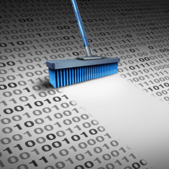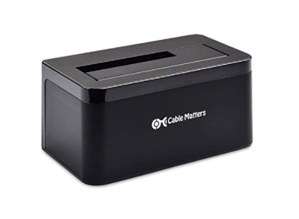Data Destruction: What It Is and How It Works
How easy is it to find a list of the passwords you use? What about your insurance details? Credit Cards? What about last year’s tax information? Where do you keep your pay stubs? For most, the answer is your computer or phone.
Your PC and phone are most likely locked with a password or by fingerprint, which is enough to keep your personal information away from most prying eyes. But what happens when that computer gets too slow, or that fancy new Samsung Galaxy takes a tumble, face first onto concrete? You’re likely to throw out your old device, but that doesn’t mean your data is gone for good.
In this guide, we’ll cover how data destruction works to make your data unreadable, inaccessible, and secure from outside parties long after your device goes kaput.
Oh oh, where does my data go?
When your electronic device reaches the end of its life, typically you throw it away (or better yet, hand it off to a recycler). But your personal data may still be accessible to outside parties - not good!
In most cases, the device you just recycled stores all its information on a hard drive. According to a study by Blancco Technology Group, 78% of used/resold hard drives still contained personal or confidential information. All those bank statements, all those tax returns, all your passwords and login info – it’s all still there.
Identify theft is no joke
The technology used by hard drives means that clicking “delete” just prevents the computer from accessing a particular “sector” of the drive. Oftentimes, that deleted file still has all its information sitting in a sector somewhere and you just can’t see it. However, there are companies and pieces of software that can get that data back even if it was deleted years ago. Unfortunately, there are too many unsavory people in the world that can do this too.
If you want your data permanently gone, you need to do a bit more than relying on simply deleting files. Improper removal of data can lead to identity theft, revenue loss, corporate espionage, lawsuits, fines, and more.
Is there any hope? Of course! We call it data destruction.
What is data destruction?
Data destruction is defined as the process of destroying data stored on hard drives, tapes, disks, and other forms of electronic media so it is completely inaccessible and unreadable. This is done typically through a software-based overwriting of the data on the device.
How data destruction works
The most common method of data destruction is using software to overwrite existing data with new files. With this method, the software writes a pattern of code (ones and zeros) that overrides the existing data and makes it unreadable.
When you write data in the exact same sector of a hard drive, it gets much harder to discern what the previous information in that sector was. If you continue this and put new data over every available sector of the drive a few times, it becomes extremely difficult, if not impossible, to figure out what information was there first. Your hard drive is now “wiped”. To even sophisticated technology, the drive is completely clear of all data.
Just like software has been developed that can recover data, so too has software been invented to help get rid of it.
Most common data destruction methods
-
Delete/Reformat - Simply deleting a file from an electronic device; not effective, as the data remains on the hard drive
-
Wipe - Overwriting data by connecting your media to a bulk wiping device. Data can be reused without your device losing storage capacity
-
Erase - Another term for overwriting; involves destroying all data stored on a hard drive, and receiving a confirmed certificate of destruction (often from a certified dealer of repurposed electronic devices)
-
Degauss - Destroys data using a high-powered magnet which disrupts the magnetic field of the device. However, this can render the hard drive inoperable
-
Shredding/physical destruction - Physically destroying hard drives and devices so they are unusable and data is made unavailable; can be unsustainable, unless you have an electronics recycling partner who can ensure e-waste is properly processed
Active @ KillDisk for data destruction
Here at Living Green Technology, we utilize a program called Active@ KillDisk, which uses well-defined processes to clear data from a drive. In the past, the United States Department of Defense (DoD) developed a standard that proved highly effective against data recovery. Most of the rest of the computer technology industry adopted this standard, leading to the often-used phrase “wiped to Department of Defense standards.” Over time though, storage technology evolved.
These changes, along with the advent of “solid state” or “flash” storage like in USB drives or smartphones, led to new standards being developed.
DIY Data Destruction Solutions
One lingering question remains…What can a security-conscious person do from home? Most people don’t have the space or the money for sophisticated data destruction technology.
The simplest option is to look around for an accredited electronics recycler. If you don’t have one nearby or you are interested in doing it yourself, we encourage you to check out two items that you can have delivered right off Amazon:
- This External Hard Drive Bay plugs into a computer with an easy-to-use USB cable and allows you to effortlessly connect any typical desktop or laptop-sized hard drive to your computer just like a thumb drive. Once you have your hard drive connected, DBAN Data Destruction Software makes it easy to wipe drives with the same standards that we use.
- If you are looking for an even easier method for quickly wiping a laptop you need to get rid of, check out REDKEY. Simply plug it into a USB port, follow the provided directions, and be confident that your important information is now secured from nefarious individuals.
Work with certified data destruction experts
Living Green Technology is a member of the National Association for Information Destruction (NAID), and we use the current industry-standard wiping method developed by the National Institute of Standards (NIST 800-88) for every drive that is recycled through our facilities.
Beyond NIST, there are approximately twenty different standards available for our use. This includes everything from Canadian OPS-II, Russian GOST, US Air Force 5020, German VSITR, NSA 130-2, and even the Peter Gutmann Standard which overwrites a drive a staggering 35 separate times. Incredibly secure, but most experts agree that it is just a little overkill.
Additionally, we offer HIPAA-compliant data destruction to any business customer upon request and apply it to every drive that is too damaged or faulty to wipe with software. All drives are processed in a secure location with comprehensive reporting of serial numbers, destruction method, and date of destruction.
Finally, we offer physical hard drive destruction for business clients using our automated hydraulic HDD Destroyer. Our crusher delivers 20 tons (40,000 lbs) of force to destroy a hard drive's magnetic data storage platters, controller, and read heads. We can also send hard drives and solid state drives to our R2 certified processor for destruction if a client prefers that method. These physical destruction services and certificates of physical destruction are available upon request.
The Living Green Technology promise
We stand behind the assurance that absolutely none of the information on any device that is recycled with us remains.
Is your organization in need of electronics recycling or data destruction services? Schedule a pickup by visiting our website, emailing info@livinggreentechnology.org, or calling us at 253.204.4438!





Let Us Know What You Thought about this Post.
Put your Comment Below.